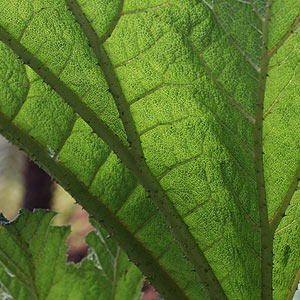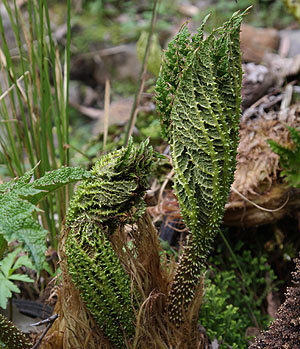
With its huge leaves Gunnera manicata is one of the wonders of the plant world. In the garden it adds texture and scale, as well as being a focal point in itself. The main attraction are the large leaves which can reach up 6ft +.
Although it does flower, the blooms are small but do rise on tall spikes
So if you are looking to add a little scale to a damp area of the garden then this could be the plant for you.
Large dramatic foliage with an architectural look are the main attraction, however these plants do die back in winter.
The preferred growing conditions are in a moist soil. Often planted by ponds or ornamental lakes, but certainly where moisture is available.
If you have the right position try growing Gunnera manicata also known as the ‘Giant’ or ‘Chilean’ Rhubarb, where you will have easy access to the massive leaves, any visitor to the garden will want to take a closer look.

Care
General Care
Preferring a humus rich moist soil Gunnera is hardy to zones 7, in colder climates some gardeners mulch over winter to protect the plant.
When the plant goes into winter dormancy the crown will need to be protected from frosts by using a mulch.
Gunnera do not like cold winds, or indeed hot winds, so plant in a protected position.
Although Gunnera can look a little unsightly when dormant, when the new growth emerges (pictured right) it will take centre stage.
Summary
- Full sun to part shade
- Humus rich moist soil
- Height 6ft in good conditions
- Clump forming
- Growth Rate – From a small plant to growing those large leaves can take around 3 years, once established it produces that large umbrella like foliage that provide a wonderful tropical look.
- Protect from winds
- Frosts and cold winter will damage the foliage and it will die right back.
- Hardy to USDA Zone 7 in most situations.
How to Plant Gunnera Manicata
If you do not have a pond and would still like to grow Gunnera you could try to create a boggy area in the garden.
- You can either use drip irrigation or dig a hole that will retain moisture through summer.
- Drip Irrigation is easy.
- To create a bog in the garden.
- Some pond liner will be need.
- Dig a hole around 2 – 3ft deep and at least this accross. Line the hole. Punch a few holes in the liner for drainage, otherwise you will have a waterlogged muddy smelly pond. Fill the hole with some good soil and plant your Gunnera.
- Some gardeners cut back the foliage once it begins to die back and use it as a mulch to protect the plants over winter. This protects the new buds from frost damage.
- It is best grown in full sun to part shade, more shade in hotter climates.
Varieties
- Gunnera tinctoria – A slightly smaller (lower) growing species. More rounded leaves and a seed head that has to be seen to be believed.
Propagation
Although you can grow Gunnera manicata and other varieties from seed you will need to be patient. Germination is slow and erratic.
Larger clumps are easily divided when dormant, basal root cuttings are the best way to propagate.

